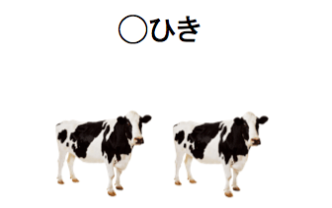Tips for More Effective Studying
Nihongo Online School > Tips for More Effective Studying > 【numbers】- Lesson 5 Counter Suffix
【numbers】- Lesson 5 Counter Suffix

2023/09/19
もののかぞえかた Counter suffix
When counting in Japanese, you will need to put certain counter words after the number. This counter word changes depend on what you count,
When you counting …
・people : にん(人)=nin
・frequency:かい(回)=kai
・animals, fish or insects :ひき(匹)=hiki
・cups/glasses of liquid: はい(杯)=hai
・counting long and thin objects like poles :ほん(本)=hon
・books:さつ(冊)=satsu
・cars and machines :だい(台)=dai
Contents
■People: にん
When counting people, using the counter “にん”. “Number+にん”. But, 1 and 2 are irregular. 3 people onwards, the rule “number + にん(nin)” is applied.

1person=ひとり hitori, 2people=ふたり futari

3 people onwards, the rule “number + にん(nin)” is applied.
| Number + peopleすうじ(数字)+にん(人) | |
| 1 | ひとり hitori |
| 2 | ふたり futari |
| 3 | さんにん san nin |
| 4 | よにん yo nin |
| 5 | ごにん go nin |
| 6 | ろくにん roku nin |
| 7 | ななにん nana nin |
| 8 | はちにん hachi nin |
| 9 | きゅうにん kyuu nin |
| 10 | じゅうにん juu nin |
| なんにん何人 | なんにん nan nin? |
■Frequency: かい
かい” is a counter that express frequency or time order. “Number+回(かい)”.

じっけんを2かいしました。
Jikkenn wo nikai shimashita.
I did experiment for 2 times.

おなじユーチューブのどうがを2かいみました。
Onaji yutube no dougawo nikai mimashita.
I watched same YouTube movie 2times.
| Number + timesすうじ(数字)+かい(回) | |
| 1 | いっかい ikkai |
| 2 | にかい ni kai |
| 3 | さんかい san kai |
| 4 | よんかい yon kai |
| 5 | ごかい go kai |
| 6 | ろっかい rokkai |
| 7 | ななかい nana kai |
| 8 | はっかい hachi kai |
| 9 | きゅうかい kyuu kai |
| 10 | じゅっかい jukkai |
| なんかい何回 | なんかい nan kai? |
■Animals, Fish or Insects :ひき
When counting small animals, fish or insects using the counter “ひき”. “Number+ひき”.

いぬが いっぴき います。
Inuga ippiki imasu.
There is a dog.

うしが にひき います。
Ushiga nihiki imasu.
There are 2 cows .
| Number+ animals/fish/insectsすうじ(数字)+ひき(匹) | |
| 1 | いっぴき ippiki |
| 2 | にひき ni hiki |
| 3 | さんびき san biki |
| 4 | よんひき yon hiki |
| 5 | ごひき go hiki |
| 6 | ろっぴき roppiki |
| 7 | ななひき nana hiki |
| 8 | はっぴき happiki |
| 9 | きゅうひき kyuu hiki |
| 10 | じゅっぴき juppiki |
| なんびき何匹 | なんびき nan biki? |
■Cups/glasses of Liquid: はい
When counting cups/glasses of liquid, using “Number + はい”.

チャイをいっぱい のみます。
Chai wo ippai nomimasu.
I drink one cup of chai.
| Number+ cups/glassesすうじ(数字)+(はい)杯 | |
| 1 | いっぱい ippai |
| 2 | にはい ni hai |
| 3 | さんばい san bai |
| 4 | よんはい yon hai |
| 5 | ごはい go hai |
| 6 | ろっぱい roppai |
| 7 | ななはい nana hai |
| 8 | はっぱい happai |
| 9 | きゅうはい kyuu hai |
| 10 | じゅっぱい juppai |
| なんはい何杯 | なんはい nan hai? |
■Counting Long and Thin Objects Like Poles :ほん
When counting long and thin objects like poles using “(ほん)”. “Number + (ほん)”.

わたしは、ペンを3ほん(ぼん)もっています。
Watashiwa, pen wo sanbon motteimasu.
I have 3 pens.
| Number+ thin and long thingsすうじ(数字)+ほん | |
| 1 | いっぽん ippon |
| 2 | にほん ni hon |
| 3 | さんぼん san bon |
| 4 | よんほん yon hon |
| 5 | ごほん go hon |
| 6 | ろっぽん roppon |
| 7 | ななほん nana hon |
| 8 | はっぽん happon |
| 9 | きゅうほん kyuu hon |
| 10 | じゅっぽん jupon |
| なんほん何本 | なんほん nan hon? |
■Books:さつ
When counting books, use the counter “さつ”. “Number + さつ”.

ここに、じゅっさつのほんがあります。
Kokoni, jussatsu no honga arimasu.
There are 10 notebooks.
わたしは、ノートを1さつ(冊)もっています。
Watashiwa, note wo issatsu motteimasu.
I have 1 notebook.
| Number+ booksすうじ(数字)+さつ(冊) | |
| 1 | いっさつ issatsu |
| 2 | にさつ ni satsu |
| 3 | さんさつ san satsu |
| 4 | よんさつ yon satsu |
| 5 | ごさつ go satsu |
| 6 | ろくさつ roku satsu |
| 7 | ななさつ nana satsu |
| 8 | はっさつ hassatsu |
| 9 | きゅうさつ kyuu satsu |
| 10 | じゅっさつ jussatsu |
| なんさつ何冊 | なんさつ nan satsu? |
■Cars and Machines :だい
When counting cars and machines, use the counter “だい”. “Number + だい”.

そこには、くるまが 2だい あります。
Sokoniwa, kurumaga nidai arimasu.
There are 2 cars.
わたしは、パソコンを2だいもっています。
Watashiwa, pasokon wo nidai motteimasu.
I have 2 PCs.
| Number+ machines and vehiclesすうじ(数字)+だい(台) | |
| 1 | いちだい ichi dai |
| 2 | にだい ni dai |
| 3 | さんだい san dai |
| 4 | よんだい yon dai |
| 5 | ごだい go dai |
| 6 | ろくだい roku dai |
| 7 | ななだいnana dai |
| 8 | はちだい hachi dai |
| 9 | きゅうだい kyuu dai |
| 10 | じゅうだい juu dai |
| なんだい何台 | なんだい nan dai? |

